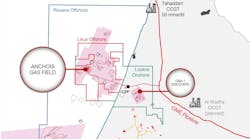Eldon Ball • Houston
Following two years of stable oil prices at a high level, spending by major, NOCs and independents is increasing steadily. That tend will continue for the foreseeable future, according to recent studies by industry analysts.
One of the most thorough examinations of future exploration and production spending comes from DnB NOR, ASA, Norway's largest financial services group. In its 5th Global E&P spending report for 2011, the banking group interviewed 65 oil companies on a number of topics ranging from future spending plans to what determines spending and where it will go.
The survey forecasts E&P spending increases of 14% in 2011, 8% in 2012 and 7% in 2013.
For 2011, the report sees activity growth in line with 2010; however, service costs are increasing and are expected to contribute one-third of the total growth rate. "We believe that this, combined with fundamentals such as an organic reserve replacement ratio of 87% and increased focus on deepwater and challenging areas, will lend good support to earnings for the oil services industry in the years to come," the report states. It also offers a number of suggestions, described below.
There will be limited downside risk. For oil companies to significantly reduce their budgets the survey indicates an oil price of US $65/bbl is required; and to trigger significant growth in budgets, an oil price of US $100/bbl is needed. Recent developments in financial markets are not reflected in the report and could well delay decision-making processes, but as long as the situation stabilizes, they remain optimistic about spending levels.
Increased spending by oil companies combined with improving utilization in most oil services segments is believed to support margin growth for the oil services sector near-term. The survey also indicates that higher services costs now account for a larger proportion of the E&P spending growth compared to the previous two years.
Majors are decreasing their relative spending on exploration activities, which is offset by the small-cap independents. The smaller companies have increased their focus on exploration activities significantly. If this trend continues, expect the bigger players to acquire resources and smaller exploration companies.
The report sees several attractive investment opportunities among the oil services companies, as long as the macro environment for the energy sector remains strong.
Oil companies are forced into deeper water and harsher environments as most of the world's easy oil is either depleted or in the hands of highly regulated nations. The focus on the deepwater segment seems to be unaffected by last year's Macondo accident. The outlook of a stable high oil price and new technology developments have made oil companies reassess mature fields.
Oil companies expect to increase their oil services capacity. Seismic, operations, and drilling are the segments they are expected to increase the most. This is a continuation of the trend from last year.
The respondents expect demand for oil services to be met in most sub-segments short-term. This should be based on the expected increased supply in several segments as oil companies plan to increase activity.
New variable bore rams will be offered by Variable Bore Rams and Cameron. The ram closes on 3-1/2-in. to 5-1/2-in. casings, allowing customers to catch most pipe sizes without changing rams. The ram will be available in October and include types U, UL, and UM 3/10M.
Golden era for services
A recent speech by Colin Welsh, chief executive officer of Simmons & Company International Ltd., echoed the sentiments of the DnB NOR report.
The next decade could be a golden era for oilfield services companies if crude prices remain at present levels, Welsh maintains.
"At existing commodity prices, the oil and gas industry can support strong levels of spending. Opex and capex spend will rise by around 18% this year, which will result in rising revenues and profits for oil service companies. This trend looks set to continue in the absence of a double dip in the economy or other financial trauma," Welsh said.
"The prospects for companies in the oil services sector are more positive than ever," he noted, "as international and deepwater activity ramps up, emerging market demand drives up commodity prices, and unconventional energy in the US and Europe starts to get exploited. We are indeed entering a significant period of growth – a golden era – for oilfield service companies."
Welsh says it is comforting that in the recent period of economic and market volatility, Brent crude has resisted the temptation to fall below $100/bbl, and WTI has been in the low $80s more often than it has been in the high $70s.
"At these levels, exploration and production companies are still making good money, and as long as there is confidence in that continuing, oilfield spending will keep increasing," he observed.
"The significantly higher prices from the lows of 2009 have been largely driven by the high rates of growth in emerging markets in India and China and also the Middle East, coupled with shrinking spare supply capacity," he commented. "The IEA has confirmed that we are entering a phase where the supply/demand balance is tightening. On top of that there is the underlying threat of interruption of supply caused by uncertainty in the Middle East."
M&A opportunities
The uncertainty of future oil prices, combined with falling share prices on both London's Alternative Investment Market (AIM) Index and the Standard and Poor's (S&P) Index in the U.S., has made close to 100 small exploration and production (E&P) companies in the U.K. and two dozen large US producers, prime targets for consolidation to achieve future funding, reports IHS in itsIHS Herold Oil and Gas Perspectives report.
"There are nearly 100 E&P companies listed on London's AIM, and while a number of these are small companies, numerous others have participated in apparently significant discoveries around the world that may turn into important oil and gas fields," said Robert Gillon, director of energy company research at IHS, and author of the weeklyIHS Herold Oil and Gas Perspectives. "However, almost none of these AIM-listed E&Ps have reached the production stage, which means they are not yet generating revenue, " said Gillon. "Without revenue, they are dependent on future funding to continue operations. That funding can be accomplished either through additional share sales or a farm-out of an interest in their exploration licenses."
In addition to the AIM-listed companies, Gillon said there are about two dozen large (market cap $0.5 billion to $3.0 billion) US oil and gas producers that could be ripe for consolidation as well. "Some of these U.S. companies are also reliant on external financing to fund their capital budgets, but all of them have developed reserves that could be sold in the very liquid transaction market," he observed.
The AIM index is now down by 40% from its recent peak, which means the average company would need to sell almost 70% more new shares to raise the same amount of money as it did a few months ago. Meanwhile, optimism about future oil prices is more subdued, and the potential farm-in partners recognize that. As a result, they will demand more favorable terms on the deal. But commitments to the host government must be honored to hold the license.
"We believe there could be a wave of consolidation in the exploration sector," said Gillon. "Selling out will become the most attractive alternative."




